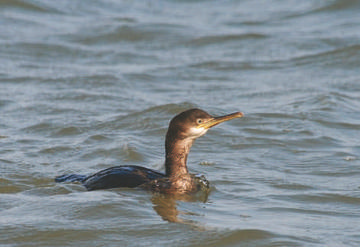Shag (Phalacrocorax aristotelis)

Shag © Sheila Blamire
Most wintering Shags prefer rocky shores, tend not to move far from their breeding sites and seek rocky cliffs and islands for overnight roosts. With that set of requirements their range in Cheshire and Wirral is bound to be limited, although the offshore sea defences and marine lakes make up for some of the natural deficiencies.
Their nearest breeding sites are on Anglesey and the Isle of Man. Adults stay close to breeding sites; most of the Shags in our area are immatures, which may disperse up to 100 km or more in the first four or five months after fledging (Migration Atlas). Their main diet elsewhere is fish, especially sandeels in the breeding season and gadoids (cod, haddock, and hake) in winter, but their food in the Irish Sea in winter is unknown.
Shags seem to have become somewhat more common in the county in recent years. A century ago the species was described as ‘an occasional wanderer to the estuaries and meres’ (Coward 1910) and fifty years ago it was ‘an occasional and, to some extent, an accidental visitor to the county’ (Bell 1962). At Hilbre, Craggs (1982) said it was ‘generally a scarce bird’ yet the annual county bird reports show more records from Hilbre than anywhere else. In the 1980s sightings appear to have been made in the county on up to 25 dates each year, and from 1990 to 2001 birds were recorded on between just four and 24 dates. A significant increase in the number of records followed with birds being seen on from 38 to 91 dates from 2003 to 2006, probably the highest ever annual figure. Some of the largest winter counts on record are during this Atlas, five birds off Hilbre on 25 January 2005 and three on West Kirby Marine Lake (SJ28D) in winter 2004/ 05 and 2006/ 07, with three also on Bird Rock, Red Rocks (SJ28E) in the intervening winter.
The Atlas map shows their typical distribution of recent years. As well as these counts, Shags were reported from Hilbre (SJ18Y/ Z) in each winter, with maxima of 5, 2 and 4 birds. Single birds were on Hoylake shore (SJ29A), Leasowe shore (SJ29W) and New Brighton Marine Lake (SJ39C).
This species is prone to occasional ‘wrecks’ when many birds, mostly immatures, are blown inland. These events are much more common on the east coast, but one was recorded in Cheshire in January 1912, when Shags turned up in extraordinary places including six birds on an araucaria (Monkey Puzzle) tree at Ashton Hayes and another on the tower of Nantwich Church. However, inland records are scarce, with just nine in forty years from 1967. Five of them, all single birds, were in winter, on the River Dee at Chester, Sutton Reservoir, Budworth Mere and Astbury Mere (twice) (CWBRs).
Sponsored by Syngenta CTL

